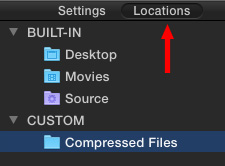 A “Location” is where Apple Compressor stores a compressed file. You can easily think of a location as the destination for the files that Compressor creates. By default, Compressor 4.2 has three default locations:
A “Location” is where Apple Compressor stores a compressed file. You can easily think of a location as the destination for the files that Compressor creates. By default, Compressor 4.2 has three default locations:
The problem is that I don’t like any of these three options. My Desktop is somewhat, ah, cluttered. Which means that if I store a new file to my Desktop there’s a better than even chance I’ll not find it; especially if I’m in a hurry.
If its a personal project, I don’t mind storing the file in my Movies folder. But for professional work, I don’t use my Home Directory at all.
And the problem with storing a compressed file in the same location as the Source file is that I need to remember where the Source file was stored. While most weeks, I’m only creating about twenty compressed files, there are times during heavy production where I’m compressing several hundred files a week. With that workload, I need a more efficient workflow to store compressed media that doesn’t require a lot of thought.
Fortunately, Compressor makes this easy. Watch.

Click the Locations tab in the left pane. (If you don’t see this option, click the blue Show in the top left corner where you see the word Hide here.)
The Locations pane displays the three default Locations, plus Custom. We will create a new Custom location.

In the lower left corner, click the Plus icon – this is Apple’s principle icon to create something new. (You need to be in the Locations pane to create a new Location.)

Here’s the important step. On one of my external hard disks, I’ve created a folder called “Compressed Files”. I use this folder as the location for ALL my compressed files. That way, if a file is in this folder I know I’ve compressed it. If it isn’t, I know that I need to compress it.
To create this custom location, simply select the Compressed Files folder and click Choose.
NOTE: You can create the Compressed Files folder anywhere, including an internal drive or shared storage. Unlike FCP X, which is very picky about what shared storage it will support, Compressor will store a file anywhere. However, I continue to recommend using external, rather than internal, drives to store media. Let internal drives support the OS and applications.
Having a single location for all compressed files simplifies my life and means that I no longer need to remember where the source file was located.

Instantly, the new Location appears in the Custom section. It can now be applied to any and all compression jobs.
NOTE: There is no limit to the number of custom Locations you can create. If having multiple locations helps your workflow, feel free to create as many as you need.
EXTRA CREDIT

To REALLY speed your workflow, change Compressor > Preferences so that the default Location matches your Compressed Files folder. This Location preference setting means that whenever you import a file for compression its location is automatically set to Compressed Files.
I use this preference constantly, which means that I never have to wonder where my compressed files are – they are always in the Compressed Files folder.